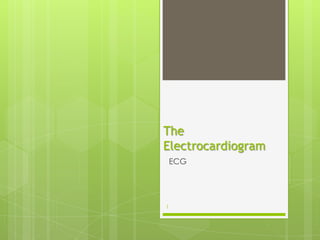
ECG
- 1. The Electrocardiogram ECG 1
- 2. 2 ECG Shows electrical pattern generated by heart as it’s activated from atrium to ventricle Muscle undergoes depolarization and repolarization during each cardiac cycle Leadsprovide us with 3D vectors that indicate direction of depolarization Looking at different projections in different directions of body
- 3. 3 Cardiac depolarization spreads from upper right to lower left (in reference to the body as a whole), considering the tilt of the heart. This is important in understanding the various ECG lead tracings
- 4. Conduction System of the Heart Sinoatrial node AV node Bundle of His Bundle Branches Purkinje fibers 4
- 5. 5 Pacemakers of the Heart SA Node - Dominant pacemaker with an intrinsic rate of 60 - 100 beats/minute. AV Node - Back-up pacemaker with an intrinsic rate of 40 - 60 beats/minute. Ventricular cells - Back-up pacemaker with an intrinsic rate of 20 - 45 bpm.
- 6. Impulse Conduction & the ECG Sinoatrial node AV node Bundle of His Bundle Branches Purkinje fibers 6
- 8. 8 Electrophysiology of the heart Different waveforms for each of the specialized cells
- 9. 9 The ECG Paper Horizontally One small box - 0.04 s One large box - 0.20 s Vertically One large box - 0.5 mV
- 10. 10 The ECG Paper (cont) 3 3 sec sec Every 3 seconds (15 large boxes) is marked by a vertical line. This helps when calculating the heart rate. NOTE: the following strips are not marked but all are 6 seconds long.
- 11. The “PQRST” P wave - Atrial depolarization QRS – Ventricular depolarization T wave – Ventricular repolarization 11
- 12. The PR Interval Atrial depolarization + delay in AV junction (AV node/Bundle of His) (delay allows time for the atria to contract before the ventricles contract) 12
- 13. 13 The ECG Tracing: Waves P- wave Marks the beginning of the cardiac cycle and measures the electrical impulse that causes atrial depolarization and mechanical contraction QRS- Complex Measures the impulse that causes ventricular depolarization Q-wave- may or may not be evident on the ECG R-wave- first upward deflection following P wave S-wave- the first downward deflection following the R- wave T- wave Marks ventricular repolarization that ends the cardiac cycle
- 14. 14 Intervals and Segments P-R interval- Time interval for impulse to go from the SA to the AV node normal 0.12-0.20 secs QRS Interval Time interval for impulse to go from AV node to stimulate Purkinjie fibers Less than 0.12 secs QT Interval Time interval from beginning of depolarization to the end of repolarization Should not exceed ½ the length of the R-R ST segment end of the S to the beginning of the T
- 15. 15 CARDIAC CYCLES Recorded on graph paper. Time is measured across (x-axis) Voltage is measured up and down. (y-axis) Small squares 1mm high 0.04 secs wide 5 small squares = 1 large square 1 large square is 5mm high and 0.20 sec wide
- 16. 16 Principles of Electrocardiograph Electrocardiograph – is the instrument that records the electrical activity of the heart Electrocardiogram (ECG) is the record of that activity
- 17. 17 ELECTRODE PLACEMENT LIMB LEADS Bipolar leads: I II III Augment leads: Avr Avl Avf CHEST LEAD 6 UNIPOLAR LEADS: V1, V2, V3, V4, V5 & V6
- 18. Limb Leads 18
- 19. 19 Chest Leads
- 20. 20 I and AVL V3 & v4 V1 & v2 II, III and AVF V5 & v6 Where the positive electrode is positioned, determines what part of the heart is seen!
- 21. 21 Normal ECG
- 22. 22
- 23. 23
- 24. 24 ECG Changes: Infarct Significant Q-wave where none previously existed Why? Impulse traveling away from the positive lead Necrotic tissue is electrically dead No Q-wave in Subendocardial infarcts Why? Not full thickness dead tissue But will see a ST depression Often a precursor to full thickness MI Criteria Depth of Q wave should be 25% the height of the R wave Width of Q wave is 0.04 secs Diminished height of the R wave
- 25. Evolving MI and Hallmarks of AMI Q wave ST Elevation 1 year T wave inversion 25
- 26. 26 A Normal 12 Lead ECG
- 27. 27 A Normal 12 Lead ECG
- 28. 28 Color Coding ECG’s Anterior Yellow indicates V1, V2, V3, V4 Anterior infarct with ST elevation Left Anterior Descending Artery (LAD) V1 and V2 may also indicate septal involvement which extends from front to the back of the heart along the septum Left bundle branch block Right bundle branch block 2nd Degree Type2 Complete Heart Block
- 29. 29 Anterior MI
- 30. 30 Color Coding ECG- Inferior Blue indicates leads II, III, AVF Inferior Infarct with ST elevations Right Coronary Artery (RCA) 1st degree Heart Block 2nd degree Type 1, 2 3rd degree Block N/V common, Brady
- 31. 31 Inferior MI
- 32. 32 Color Coding ECG- Lateral Redindicates leads I, AVL, V5, V6 Lateral Infarct with ST elevations Left Circumflex Artery Rarely by itself Usually in combo
- 33. 33 Lateral MI
- 34. 34 Color Coding ECG- Posterior Green indicates leads V1, V2 Posterior Infarct with ST Depressions and/ tall R wave RCA and/or LCX Artery Understand Reciprocal changes The posterior aspect of the heart is viewed as a mirror image and therefore depressions versus elevations indicate MI Rarely by itself usually in combo
- 35. 35 Posterior MI
- 36. 36 Color Coding ECG- SubEndo No color for SubEndocardial infarcts since they are not transmural Look for diffuse or localized changes and non – Q wave abnormalities T-wave inversions ST segment depression
- 37. 37 SubEndo MI
- 38. 38 More than one color shows abnormality A combination of infarcts such as: Anterolateral yellow and red Inferoposterior blue and green Anteroseptal yellow and green
- 39. 39 Putting it ALL together
- 40. 40
